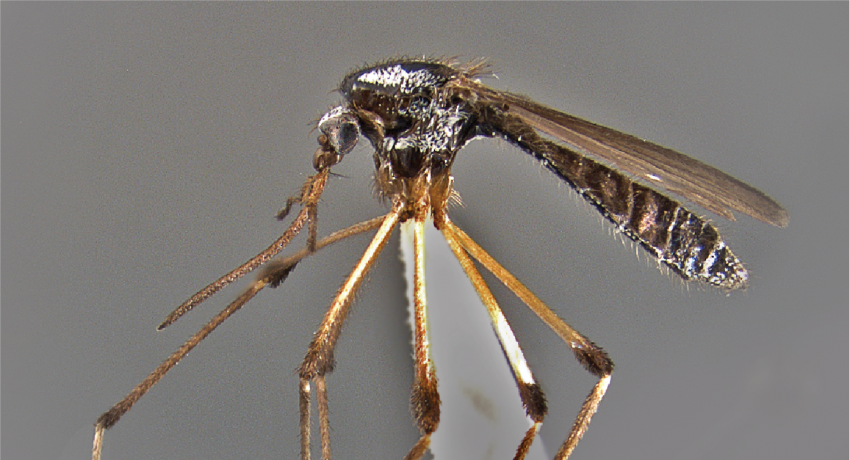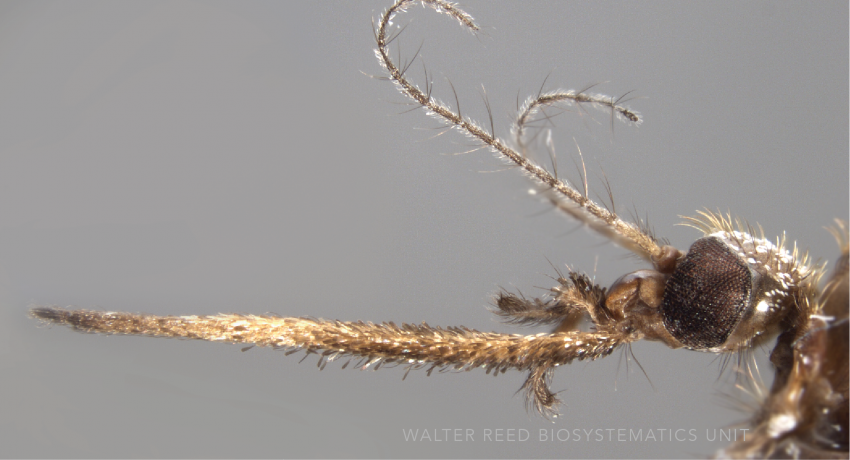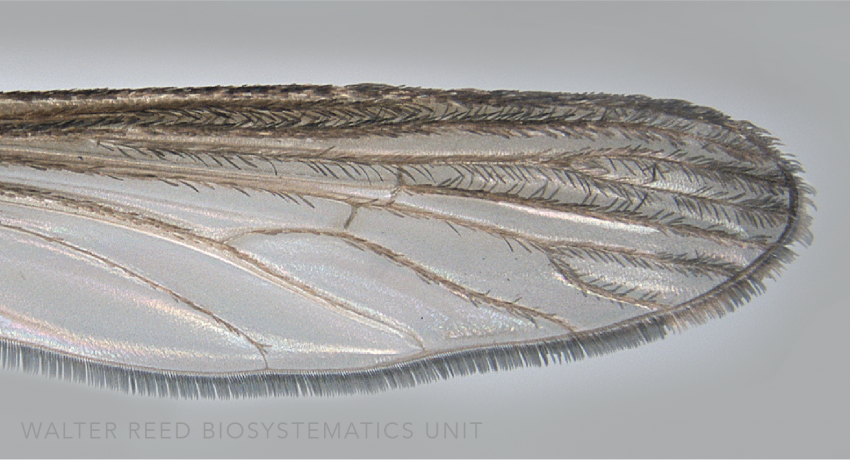NEARCTIC & NEOTROPICAL REGIONS
Etymology: not stated [eyelid (L); possibly refers to hairs on wings and legs]
The floodwater species Psorophora ciliata is the largest mosquito in North America, renowned for its ferocity and painful bites. It is the nominotypical species of the genus Psorophora. Specimens from Venezuela show notable morphological differences in leg and thorax markings to populations from the United States, Mexico and Jamaica (which correspond to the type), suggesting that Ps. ciliata comprises at least two species. Three synonyms currently exist: Ps. cyanopennis from Colombia (Humboldt), Ps. tibialis (Robineau-Desvoidy) from Brazil, and Ps. lynchi Brèthes from Argentina.
Type locality: Vicinity of Ten Mile Station, Charleston County, South Carolina, United States
Type depository: Type non-existent (NE)
DIAGNOSTIC CHARACTERS (Click photos to view; mouse over and click large photo to zoom in.)
ADULT (illustrated): Wings: Vein 1A speckled black and white along entire length. Legs: Fe-III with narrow preapical white band; Ta-III1 with basal and median pale bands; U-III long, single, without a basal tooth. Abdomen: Dark and white scales randomly scattered.
LARVA (not illustrated): Head: Antenna long, reaching well beyond front of head; setae 5,6-C ≥4-branched; head rounded anteriorly. Terminal segments: Seta 5-VIII 2,3 branched; 5–6 comb scales usually on edge of weakly sclerotized plate; <8 small pecten spines; siphon centrally swollen; seta 1-S small or tiny with ≥3 branches; seta 2-S small, weak, and straight.
TAXONOMIC KEYS
Carpenter & LaCasse 1955
Ross & Horsfall 1965
Dodge 1966
Darsie & Ward 2005
Harrison et al. 2016
Exemplar DNA sequences
Ps. ciliata COI: MG242533
BIONOMICS
Immatures
Immature Ps. ciliata are predacious, feeding primarily on the larvae of other sympatric mosquito species, with lesser reports of cannibalism and even feeding on tadpoles. The large, square-headed larvae have modified mouthparts designed to grip and immobilize prey. Larva develop quickly (4–6 days) in these temporary environments, with the pupal stage lasting only two days. They are found in highest numbers in rice fields, although the species is relatively rare overall.
Adults
Females carefully lay elongate, ovoid eggs into unshaded cracks in the soil, potholes or small ground depressions, prone to flooding. Despite flooding, it is thought that eggs of Ps. ciliata are remain in aestivation, until they have overwintered. Psorophora ciliata are painful, persistent biters, attacking at any time of the day. In Florida, Ps. ciliata are primarily mammalophilic, with hosts shown to include man, ruminants, ovids, rabbits, armadillos and raccoons.
DISTRIBUTION NOTES
Argentina, Belize, Bolivia, Brazil, Canada, Cayman Islands, Colombia, Costa Rica, Ecuador, El Salvador, French Guiana, Guatemala, Honduras, Mexico, Panama, Paraguay, Peru, Suriname, United States (continental), Uruguay, Venezuela.

WRBU VECTOR HAZARD REPORTS
None; View other WRBU Vector Hazard Reports
Available GIS Models:
None
IMPORTANT REFERENCES (full citations below)
Fabricius 1794: 401 (A; Culex ciliata [sic])
Mitchell 1907 (E*)
Howard et al. 1913 (1912) (E*)
Peterson 1916, figs. (A)
Howard et al. 1917 (E)
Schwardt 1939: 16 (E*; bionomics)
Ross 1947: 87 (M*, F*, L*)
Knight & Chamberlain 1948, Fig. 23 (P*)
Yamaguti & LaCasse 1951b: 40 (M*, F*, L*)
Horsfall et al. 1952: 618 (E*)
Lane 1953: 733 (M*, F, P*, L*)
Carpenter & LaCasse 1955: 114 (M*, F*, L*; keys)
Guedes et al. 1965: 5 (M*, F*)
Ross & Horsfall 1965 (M*, F*, L*, E*; keys)
Belkin et al. 1966: 3 (restriction of type locality)
Dodge 1966: 380 (1st instar L*; key)
Belkin 1968b: 26 (taxonomy)
Belkin et al. 1970: 121 (M*, F, P*, L*)
Horsfall et al. 1970: 1714 (E*)
Mattingly 1971a: Pl. 16 (P abdomen*)
Wallis & Whitman 1971 (bionomics)
Heinemann & Belkin 1977b: 415 (distribution)
Reinert 2000e: Fig. 3 (F*)
Darsie & Ward 2005 (F*, L*; keys, distribution)
Liria & Navarro 2007 (morphology; cibarial armature*)
Berti et al. 2015 (distribution; Venezuela)
Harrison et al. 2016 (F*, L*; keys, distribution)
CURRENT SYNONYMS
syn. cyanopennis von Humboldt
1819: 340 (A; Culex). Type locality: Magdalena River, close to Teneriffe, Colombia (NE). References: Belkin 1968b: 26 (taxonomy).
syn. molestus Wiedemann
1820: 7 (F; Culex). Type locality: Georgia Amer. [United States] (NMW). References: Belkin 1968b: 27 (tax., lectotype designation).
syn. rubidus Robineau-Desvoidy
1827: 404 (F; Culex). Type locality: Vicinity of Ten Mile Station, Charleston County, South Carolina, United States (NE). References Belkin et al. 1966: 4 (restriction of type locality).
syn. tibialis Robineau-Desvoidy
1827: 404 (F; Culex). Type locality: Rio de Janeiro, Guanabara, Brazil (NE). References: Belkin et al. 1971: 18 (restriction of type locality).
syn. boscii Robineau-Desvoidy
1827: 413 (A; Culex). Type locality: Vicinity of Ten Mile Station, Charleston County, South Carolina, United States (NE). References: Belkin et al. 1966: 3 (restriction of type locality).
syn. conterrens Walker
1856a: 427 (F; Culex). Type locality: Vicinity of Ten Mile Station, Charleston County, South Carolina, United States (NHMUK). References: Belkin et al. 1966: 3 (restriction of type locality).
syn. lynchi Brèthes
1916: 204 (M*, F). Type locality: Argentina (BA). References: Belkin et al. 1968: 12 (lectotype designation according to Casal).
syn. ctites Dyar
1918d: 126 (F). Type locality: Brownsville, Texas, United States (USNM). References: Stone & Knight 1955: 283 (lectotype designation).
CITED REFERENCES
Belkin, J.N. (1968b). Mosquito studies (Diptera, Culicidae). IX. The type specimens of New World mosquitoes in European museums. Contributions of the American Entomological Institute, 3(4), 1–69.
Belkin, J.N., & Heinemann, S.J. (1971). Aedes vexans in Guatemala. Mosquito Systematics Newsletter, 3(2), 27.
Belkin, J.N., Heinemann, S.J., & Page, W.A. (1970). The Culicidae of Jamaica (Mosquito studies. XXI). Contributions of the American Entomological Institute, 6(1), 458.
Belkin, J.N., Schick, R.X., & Heinemann, S.J. (1966). Mosquito studies (Diptera: Culicidae). VI. Mosquitoes originally described from North America. Contributions of the American Entomological Institute, 1(6), 1–39.
Belkin, J.N., Schick, R.X., & Heinemann, S.J. (1968). Mosquito studies (Diptera, Culicidae). XI. Mosquitoes originally described from Argentina, Bolivia, Chile, Paraguay, Peru, and Uruguay. Contributions of the American Entomological Institute, 4(1), 9–29.
Belkin, J.N., Schick, R.X., & Heinemann, S.J. (1971). Mosquito studies (Diptera, Culicidae). XXV. Mosquitoes originally described from Brazil. Contributions of the American Entomological Institute, 7(5), 1–64.
Berti, J., Guzmán, H., Estrada, Y., & Ramírez, R. (2015). New records of mosquitoes (Diptera: Culicidae) from Bolívar State in South Eastern Venezuela, with 27 new species for the state and 5 of them new in the country. Frontiers in Public Health, 2, 10.
Brèthes, J. (1916). Algunas notas sôbre mosquitos Argentines, su relation con las Énfermedades palúdicas, etc., y description de très espécies nuevas. Anales del Museo Nacional de Historia Natural de Buenos Aires, 28, 193–218.
Carpenter, S.J., & LaCasse, W.J. (1955). Mosquitoes of North America (North of Mexico). Berkeley, Los Angeles: University of California Press.
Darsie, R.F., Jr., & Ward, R.A. (2005). Identification and geographical distribution of the mosquitoes of North America, north of Mexico. Gainesville, FL: University Press of Florida.
Dodge, H. R. (1966). Studies on mosquito larvae II. The first-stage larvae of North American Culicidae and of world Anophelinae. Canadian Entomologist, 98, 337–393.
Dyar, H.G. (1918d). New American mosquitoes (Diptera, Culicidae). Insecutor Inscitiae Menstruus, 6, 120–129.
Fabricius, J.C. (1794). Entomología systematica emendata et aucta. Impr. Christ. Gottl. Proft (Hafniae).
Guedes, A.S., Souza, M.A., Maciel, C.S., & Xavier, S.H. (1965). Catalogo illustrado dos mosquitoes da coleçao do Instituto Nacional de Endemias Rurais I. Genero Psorophora Robineau-Desvoidy, 1827. Revista Brasileira de Malariologia e Doenças Tropicais (Rio de Janeiro), 17, 3–24.
Harrison, B.A., Byrd, B.D., Sither, C.B., & Whitt, P.B. (2016). The mosquitoes of the Mid-Atlantic Region: an identification guide (Vol. 1). Madison Heights, MI: Publishing XPress.
Heinemann, S.J., & Belkin, J.N. (1977b). Collection records of the project Mosquitoes of Middle America 8. Central America: Belize (BH), Guatemala (GUA), El Salvador (SAL), Honduras (HON), Nicaragua (Nl, NIC). Mosquito Systematics, 9(4), 403–454.
Horsfall, W.R., Miles, R.C., & Sokatch, J.T. (1952). Eggs of floodwater mosquitoes. I. Species of Psorophora (Diptera: Culicidae). Annals of the Entomological Society of America, 45(4), 618–624.
Horsfall, W.R., Voorhees, F.R., & Cupp, E.W. (1970). Eggs of floodwater mosquitoes. XIII. Chorionic sculpturing. Annals of the Entomological Society of America, 63, 1709–1716.
Howard, L.O., Dyar, H.G., & Knab, F. (1913). The mosquitoes of North and Central America and the West Indies. (Vol. II) (1912). Washington, D.C.: Carnegie Institution of Washington.
Howard, L.O., Dyar, H.G., & Knab, F. (1917). The mosquitoes of North and Central America and the West Indies. Systematic description. Part II. Carnegie Institute of Washington.
Knight, K.L., & Chamberlain, R.W. (1948). A new nomenclature for the chaetotaxy of the mosquito pupa, based on a comparative study of the genera (Diptera: Culicidae). Proceedings of the Helminthological Society of Washington, 15, 1–18.
Lane, J. (1953). Neotropical Culicidae (Vols. I, II). São Paulo: University of São Paulo.
Liria, J., & Navarro, J.-C. (2007). Morfología del cibario en subgéneros de Psorophora Robineau Desvoidy (Diptera: Culicidae). Neotropical Entomology, 36(6), 902–909.
Mattingly, P.F. (1971a). Contributions to the mosquito fauna of Southeast Asia. XII. Illustrated keys to the genera of mosquitoes (Diptera, Culicidae). Contributions of the American Entomological Institute, 7(4), 1–84.
Mitchell, E.G. (1907). The classification of the Culicidae. Canadian Entomologist, 198–201.
Peterson, A. (1916). The head-capsule and mouth-parts of Diptera. Illinois Biological Monographs, 3(2), 177–282, 125 pls.
Reinert, J.F. (2000e). Comparative anatomy of the female genitalia of genera and subgenera in tribe Aedini (Diptera: Culicidae). Part V. Genus Aedes Meigen. Contributions of the American Entomological Institute, 32(3), 1–102.
Robineau-Desvoidy, A.J.B. (1827). Essai sur la tribu des culicides. Société d’histoire naturelle, 3, 390–413.
Ross, H.H. (1947). The mosquitoes of Illinois (Diptera, Culicidae). Bulletin of the Illinois Natural History Survey, 24(1), 1–96.
Ross, H.H., & Horsfall, W.R. (1965). A synopsis of the mosquitoes of Illinois (Diptera, Culicidae). Illinois Natural History Survey Biological Notes, 52, 1–50.
Schwardt, H.H. (1939). Biologies of Arkansas rice field mosquitos. Bulletin of the Arkansas Experiment Station, 377, 1-22.
Stone, A., & Knight, K.L. (1955). Type specimens of mosquitos in the United States National Museum: I. The genera Armigeres, Psorophora and Haemagogus (Diptera, Culicidae). Journal of the Washington Academy of Sciences, 282–289.
Taylor, B., & Maffi, M. (1971). Contribution to the knowledge of Aedes (Stegomyia) hoguei Belkin 1962 (Diptera: Culicidae). Pacific Insects, 13, 119–121.
von Humboldt, F.H.A. (1819). Voyage aux regions equinoxiales du Nouveau Continent, fait en 1799, 1800, 1801, 1802, 1803 et 1804 par Al. de Humboldt et A. Bonpland; Vol. 2, 722 pp. In: Humboldt, F.H.A., Ed., Voyage de MM Alexandre de Humboldt et Aime Bonpland. Pt. I: Relation historique. Paris.
Walker, F. (1856a). Insecta Saundersiana: or characters of undescribed insects in the collection of William Wilson Saunders, Esq., F.R.S., F.L.S., & c. Vol. I. Diptera. London: John van Voorst.
Wallis, R. C., & Whitman, L. (1971). New collection records for Psorophora ciliata (Fabricius), Psorophora ferox (Humboldt) and Anopheles earlei Vargas in Connecticut (Diptera: Culicidae). Journal of Medical Entomology, 8(3), 336–337.
Yamaguti, S., & LaCasse, W. J. (1951b). Mosquito fauna of North America. Part III. Genera Orthopodomyia, Mansonia and Psorophora. Office of the Surgeon, Headquarters, 8th Army, APO 343. United States. Office of the Surgeon-General. 207th Malaria Survey Detachment.
CITE THIS PAGE
Walter Reed Biosystematics Unit (Year). Psorophora ciliata species page. Walter Reed Biosystematics Unit Website, http://wrbu.si.edu/vectorspecies/mosquitoes/ciliata, accessed on [date (e.g. 03 February 2020) when you last viewed the site].











































































































































































